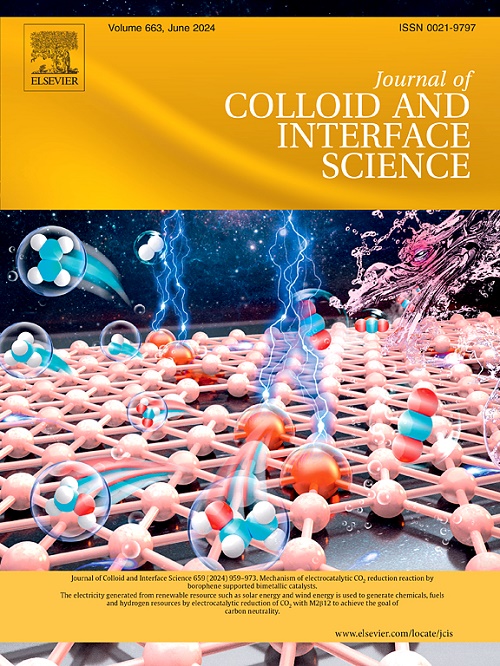玄武岩纤维和三氧化铁改性羰基铁粉/环氧涂料的电磁波吸收性能和耐蚀性研究。
IF 9.7
1区 化学
Q1 CHEMISTRY, PHYSICAL
引用次数: 0
摘要
随着科学技术的发展,军用和民用对电磁波吸波材料的需求越来越大。其中羰基铁粉(CIP)因其成熟的生产体系和良好的电磁波损耗能力而备受关注。但由于阻抗匹配性差,耐腐蚀性差,抗氧化性差,限制了CIP的应用。在此基础上,本研究利用CIP和玄武岩纤维(BF),通过水热法在其表面原位生成花状的三氧化铁(Fe3O4)。结果表明,Fe3O4的生成和BF的加入极大地优化了CIP的阻抗匹配。改性后的CIP的最小反射损耗为-51.09 GHz,对应有效吸收带宽为3O4,改性后的CIP粉末在空气中的氧化增重温度从240℃提高到500℃,表现出良好的热稳定性和抗氧化性。此外,利用电化学阻抗谱(EIS)测试和分析了涂层的耐蚀性。结果表明,涂层在0.01 Hz时的阻抗模量由106 Ω·cm2提高到107 Ω·cm2,提高了一个数量级。最后,利用CTS软件模拟材料的雷达截面(RCS),进一步评价材料的吸波性能。本文章由计算机程序翻译,如有差异,请以英文原文为准。

An investigation on the electromagnetic wave absorbing performance and corrosion resistance of carbonyl iron powder/epoxy coatings modified by ferrosoferric oxide and basalt fibers
With the development of science and technology, there is a great demand for electromagnetic wave absorbing materials for both military and civilian purposes. Among them, carbonyl iron powder (CIP) has attracted a lot of attention due to its mature production system and good electromagnetic wave loss capability. However, the application of CIP is limited due to poor impedance matching, poor corrosion resistance, and poor oxidation resistance. Based on this, in this work, CIP and basalt fibers (BF) were used and flower-like ferrosoferric oxide (Fe3O4) was generated in situ on their surfaces by hydrothermal method. The results showed that the generation of Fe3O4 with the addition of BF greatly optimized the impedance matching of the CIP. The modified CIP had a minimum reflection loss of −51.09 GHz, corresponding to an effective absorption bandwidth (<−10 dB) of 6.16 GHz, fully covering the Ku-band with just a 1.5 mm coating thickness. Thanks to the protective effect of Fe3O4, the oxidation weight gain temperature of the modified CIP powder in air was increased from 240 °C to 500 °C, showing good thermal stability and oxidation resistance. In addition, the corrosion resistance of the coating was tested and analyzed using electrochemical impedance spectroscopy (EIS). The results showed that the impedance modulus of the coating at 0.01 Hz was enhanced by one order of magnitude from 106 Ω·cm2 to 107 Ω·cm2. Finally, the radar cross section (RCS) of the material was simulated using CTS software to further evaluate the wave absorption properties.
求助全文
通过发布文献求助,成功后即可免费获取论文全文。
去求助
来源期刊
CiteScore
16.10
自引率
7.10%
发文量
2568
审稿时长
2 months
期刊介绍:
The Journal of Colloid and Interface Science publishes original research findings on the fundamental principles of colloid and interface science, as well as innovative applications in various fields. The criteria for publication include impact, quality, novelty, and originality.
Emphasis:
The journal emphasizes fundamental scientific innovation within the following categories:
A.Colloidal Materials and Nanomaterials
B.Soft Colloidal and Self-Assembly Systems
C.Adsorption, Catalysis, and Electrochemistry
D.Interfacial Processes, Capillarity, and Wetting
E.Biomaterials and Nanomedicine
F.Energy Conversion and Storage, and Environmental Technologies

 求助内容:
求助内容: 应助结果提醒方式:
应助结果提醒方式:


